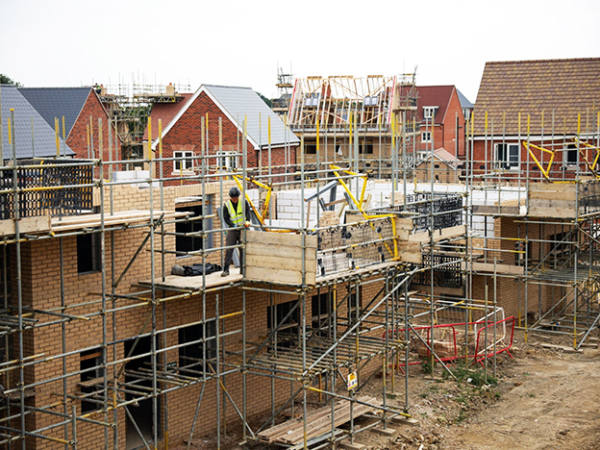Three cheers, the war is over! Interest rates are about to tumble and the housebuilders are off to the races. Or so the predominant market narrative of recent weeks would have it. But hold fast, the fortunes of these shares are not dependent on changing interest rates alone. This sector has experienced one of its frequent surges, but investors should remain wary, not be overly fearful of missing out, and should look at a wide range of factors rather than taking a blinkered view that concentrates solely on rates of interest.
Don’t see what isn’t there
We suggested in our previous articles in this series that the recovery for the housebuilders’ profits is likely to be longer, harder and to a lower peak than might be expected if reading across from the profile of previous cycles. We stick with that view, still see a hard slog ahead, and caution strongly against thinking that this sector’s recent past is in any way a template for its future. The reasons are as follows:
A time will come, eventually
There will be a right time to buy this sector for a prolonged period of fairly decent returns, but it doesn’t feel as though we are there yet. Forecasts are still too high and the expected pace of any rebound is, as reflected in the analyst consensus, too steep. In many cases, the consensus forecasts for the bottom of this cycle (probably in 2025) could easily still be 30 per cent too high – that means lots of downgrades, lowered guidance or even profit warnings still to come. Remember the norm here is to expect a ‘V’ shaped recovery but we believe it will instead be ‘bath’ shaped.
At the same time, while it may sound counter-intuitive, the ratings in the sector are not yet high enough (yes high, not low) to be a buy signal. Ideally you buy this sector when a realistically-set consensus indicates price/earnings (PE) ratios of more than 15 times and management teams have stopped suggesting that they see ‘green shoots’ or that the market rebound has begun. Despite their years of experience in the sector, housebuilder management teams (with one exception) are actually pretty bad at reading the cycle.
All that said, the question remains: when the time does come, what stocks should investors pick?
Persimmon (PSN) – amplifying market woes
A long-time favourite in this sector, PSN has posted one of the worst performances in the near term, falling more than 70 per cent since its early 2021 high point, and the shares recently reached their lowest point in more than 10 years. That said, investors have still seen an average TSR here of 4.5 per cent thanks to the now terminated ‘capital return’ via high dividends. Persimmon has relied too heavily on first-time buyers (most impacted by rate rises) and had also leaned too much on the now-withdrawn HTB. Add in unwelcome management changes (this was always largely an autonomous federation of businesses; the board is now trying to exert central control – it’s not working) and this business looks to be facing a quality of earnings issue that is depressing its rating. On top of this, growth looks set to lag behind its peers’, so this should no longer be a first choice.
Vistry (VTY) – trying to change its spots
Typically, players in this sector just have to lie back and take what the market hands out to them, wholly reliant on government or lenders’ mortgage policies and the return of house price inflation. It is unusual, therefore, to see a housebuilder try to change its spots. Vistry (the agglomeration of Bovis Homes, Linden Homes and Countryside Properties) is planning, essentially, to pull out of private new home sales and sell only to largescale buyers such as corporate landlords or housing associations. This sounded great on paper, and the shares initially surged as much as 20 per cent, but doubts about overambition crept in and the shares lost all of that initial surge and more.
An issue to consider here is deliverable scale. Vistry targets annual sales of comfortably over 20,000 new homes; this is a figure that will rattle long-standing industry observers. For UK housebuilders, 20,000 units a year has long proved to be something of an Icarus paradox. Several attempts to pass this production barrier have been made, always with the same result – the wax melts and the housebuilder falls to earth. There is concern that Vistry goes the same way – the name may have changed, but this is still the Bovis Homes that, in 2016, became a byword for shoddy workmanship as it tried too hard to run too fast.
With Vistry in particular, don’t expect the share price to rise once mortgage rates drop and the private buyer market finally begins to pick up. By focusing on social housing, Vistry is decoupling from interest rate moves, house prices and mortgage approvals. So, in whatever cyclical recovery eventually arises, Vistry is likely to lag its peers. Investors need to be careful not to mistake this as a share price being left behind – Vistry is going to be a very different animal. On top of this, there are likely to be large cash returns as the company unwinds its working capital. Again, don’t mistake this for a new normal. This balance sheet unwinding will be a one-time-only exercise, and how much of its profit the company eventually chooses to distribute is yet to be determined. That said, there could be a very high distribution ratio in time.
So, Vistry is a stock aiming for a very different and potentially more stable earnings stream – the jury is still out on this one, plus no-one really knows how to value this kind of model. But a 10 times PE on likely 2025 earnings per share (EPS) (c105p) could deliver a double-digit TSR. Speculative, but well worth a closer look.
Berkeley Group (BKG) – still the one to own?
Historically, when asked which single housebuilder to buy and hold, the answer was (unhesitatingly) Berkeley. Returns here did outpace the sector over 10 years but not materially more than, say Redrow (RDW) or Bellway (BWY). Will it manage to pull yet another very different rabbit from a very different hat and read the cycle much better than the rest? That feels harder to discern, but for innovation and smart thinking this is probably still the core stock to own in this sector. However, at 4,500p, it is no bargain.
Crest Nicholson (CRST) – banana skins
This is a great favourite for speculators because of its high volatility, or ‘beta’ in market-speak. The stock is volatile because it seems to find banana skins the rest of the sector manage to avoid. While most of the housebuilders have managed to make investors a positive TSR over 10 years, Crest is alone in showing a negative. Buying the worst in the hope that it will get it right next time around is a bit like gamblers’ folly – strictly one for the traders.
Taylor Wimpey (TW.) – will they, won’t they?
Taylor Wimpey has long sought to present itself as something a little different. That is evident in the way it describes itself (a land developer not a housebuilder), the use of mega sites (1,000 or more units) split into sub-sites called ‘factories’, and how it pays a dividend. Its peers pay a proportion of earnings (33 or 50 per cent) but Taylor Wimpey opts to pay a set percentage of its net asset value (NAV). This means that unless it changes its policy it will not be able to reduce its dividend, as NAVs are unlikely to fall in this cycle. Other housebuilders are able to save a lot of cash by lowering their payments, and this could lead to Taylor Wimpey lagging its peers in any recovery. It’s hard to see value here, plus the dividend policy feels at risk. There is a potential high yield, but at a price.
Barratt (BDEV) – too much faith
The problem here is that analysts seem to be expecting too much of a rebound – the bulls believe 2025/26 profits can come within 20 per cent of the last cycle peak, which is a very big ask. This feels like a stock for which forecasts are awaiting a sizable reality check, and one that is overbought after surging almost a quarter in the past month.
Redrow and Bellway – just getting the job done
We have clubbed these together because they are both no-nonsense, get-on-with-the-job housebuilders that have both made better returns than their larger peers in the past decade. Neither is afraid to use debt to grow, they happily roll with the cycle, have very solid management and both are likely to offer steady recovery. Again, there are no bargains here, but take a five-year view and a high single-digit TSR should be possible, as well as more chance of longer-term stability.









